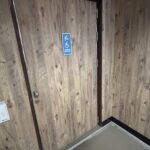 The other day someone asked me whether a maintained or momentary switch should be used in a certain type of access control system, and I realized that I have never written about this “Electronics 101” concept. It’s an important clarification though, because using the wrong switch can cause problems with code-compliance and functionality.
The other day someone asked me whether a maintained or momentary switch should be used in a certain type of access control system, and I realized that I have never written about this “Electronics 101” concept. It’s an important clarification though, because using the wrong switch can cause problems with code-compliance and functionality.
For starters, there are 4 components of a simple access control circuit – the power supply, load, conductor, and switch. There may be multiples of these components in a system – for example, several electrified locks (loads), each with electric power transfers (conductors), and separate push buttons or readers (switches).
When installing a switch, it’s important to know whether the system requires maintained or momentary operation. In simple terms, a maintained switch changes position when actuated, and stays in that position until actuated again – examples would be a lightswitch or the power button on my 1980’s stereo system. A momentary switch is actuated only when someone is pressing it – like a doorbell.
Both types of switches are used with electrified hardware. An actuator for an automatic operator is a momentary switch, and the button a receptionist uses to “buzz someone in” is often momentary as well – the door stays unlocked as long as the receptionist is pressing the button. If a door is left unlocked for longer periods of time, a maintained switch would be used – push to unlock, push again to lock.
There are also also switches that are sort of a hybrid – such as the switch used with a sensor-release system, where the lock is unlocked by a sensor on the egress side which detects an approaching occupant. This type of system is required by code to have an auxiliary push button that unlocks the door for 30 seconds – independent of the other electronics. The switch will have a built-in timer that keeps the door unlocked for 30 seconds, and then goes back to the normal locked state.
Any questions?
You need to login or register to bookmark/favorite this content.





I agree, simple, but a very good idea for a post.
Thanks
what if the exit door equipped with eletro megnetic lock which need card to activate or push button to diactivate the door magnetic. is it ok for such panic doors.
Hi Binny –
There are two ways to provide a code-compliant door opening with electromagnetic locks (in addition to delayed egress and controlled egress). They are both covered in this video: https://idighardware.com/2018/02/code-requirements-for-electromagnetic-locks-video/.
– Lori